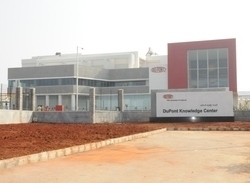
But the team looked at it as a tremendous opportunity for playing a role in Environment Stewardship. They had to oversee numerous factors and both site and operational parameters in helping reduce the impact on our surroundings and ensure all criteria was met to be LEED-certified, without a glitch.
In his words, Nitish Dikshit-Site Manager DKC recalls, “We probably never knew what we were getting into. But as we got more involved we could clearly see the long term sustainability benefits of going green. The certification was much aligned to DuPont Core Values and commitment in ensuring Environment footprint and sustainability is at the core of it’s operations.”
| Getting LEED certification is about addressing certain specifications and parameters outlined by IGBC. • Sustainable site • Water Efficiency • Energy and Atmosphere • Material & Resources • Indoor Environmental Quality |
 |
So here is what the team had to do to get it’s certification:
Sustainable site – Measures impact of buildings on their immediate surroundings and transporting people to the building and the initial selection of the building site.
| Measures taken: • Soil erosion and sedimentation control plan includes features like stock-piling of topsoil for reuse & prevents soil erosion by rainfall, flowing water or wind. Technologies like Temporary/ Permanent seeding, Mulching etc. are used for soil stabilization whereas Site Fencing, Sediment Trap/ Basin are used to divert surface runoff volumes and help settling of sediments • The center was built on a site that was not an agricultural land with clearances from Ministry of Environment and Forest, (MoEF), |
 |
Benefits:
• Prevents loss of soil during construction and sedimentation of storm sewers and nearby streams.
• Does not affect prime farmland, flood prone land, public parkland and other eco-sensitive zones
• Encourages use of public transportation- reducing the overall vehicular footprint and ultimately air pollution
• Encourages use of low-emitting and fuel-efficient vehicles
• Minimize disruption and pollution of natural water flows by effective storm water management plan
Water Efficiency - rates the efficiency of potable water usage in the building, encouraging rainwater collection, low-flow fixtures, and grey water recycling.
Measures taken:
• The water-efficient landscaping design incorporates drought tolerant or native plant species with high efficiency irrigation systems to reduce the potable water requirement for irrigation purpose.
• Complete waster water is recycled
• Usage of water efficient plumbing fixtures including sensor based urinals & faucets and low flow showers to reduce the water consumption.
Benefits:
• Average monthly reduction of potable water for irrigation purpose is about 66%
• Water usage reduced by over 25%
Energy and Atmosphere - rates the energy efficiency of the equipments, building systems and of overall built form. It emphasizes on building commissioning, energy modeling simulation practices and use of green power for optimized energy performance.
|
Measures taken: |
 |
Benefits:
• Enhanced energy efficiency
• Reduction in Ozone depletion
Material & Resources - rates the impact of a building on its global resource use (wood, steel, stone, fossil fuels), regional landfills, local industries (manufacturing and harvesting), and embodied energy of building materials.
Measures taken:
• Efficient waste management through proper collection, segregation, storage and recycling of waste depending upon nature of material- chemicals, bio-hazard, construction material, plastics etc
• Material used in construction is as local as possible (source of material is within an 800 km. radius) and majority of the content of the material used is recyclable (eg. Wooden furniture)
Benefits:
• Reduction in the quantity of waste generated at site from going directly to landfills.
• More than 75% of the total waste generated on site has been diverted from going to landfill sites.
Indoor Environmental Quality - rates the impact of a building on the people who occupy it. It considers VOC levels emitted from carpets, paints etc. and use of natural light and fresh air to enhance the health, comfort, and productivity in buildings.
| Measures taken: • Design in compliance with ASHRAE 62.1-2004 standards • Ventilation is 30% more than the required standard • Tobacco-free campus • Interior paints used are flat paints with a VOC (volatile organic compound are the chemical concentration releases to environment when exposed to variations in climate) content of 29 g/L |
 |
Measures taken:
• Green Educational program implemented to create awareness about sustainability and green buildings for employees and visitors including a comprehensive signage program and a guided campus tour
• Comprehensive green housekeeping and training manual to ensure correct and proper specifications are adhered to cleaning methods and products
• Changing construction and design of tables, proper height…incl training
• Constructed compost pits, filled them with organic waste and the fertilizer will be ready to use in January.
Benefits:
• Creating awareness about sustainability and Green buildings amongst its employees and visitors
• healthier and cleaner environment by using products and cleaning methods that cause less toxic pollution and waste, conserve resources and habitats, and minimize global warming and ozone depletion
• reduce occupational health hazards
• Effective utilization of organic waste as part of overall waste management strategy.